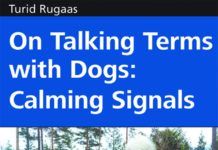It’s said all the time that dogs are social animals, and it’s true. As a species, they’re not meant to be by themselves. They do better in packs, and because of our unique relationship with them, those packs can include people as well as other dogs. Nonetheless, some dogs are clearly not happy in the company of other dogs; they either cower or threaten. Both, in the main, are signs of fear. Threatening postures and growls can seem like anything but fear, yet they are a scared dog’s attempt to keep other dogs at bay.
While some dogs fear fellow dogs, others fear people — and likewise, will cower or act aggressively to protect themselves.
The reason for the maladaptation to other dogs, or to people, is that some dogs have endured unfortunate circumstances or incidents when they were very young, often during the tender period of socialization in their first few months. Something happened that spooked them or outright traumatized them, and their view of others gelled with a certain fear, or suspicion or guardedness, in the scaffolding of their psyches.
Of course, it pains loving owners to see their dogs unable to socialize successfully, and can also be a pain. The dog has to be watched carefully to make sure he doesn’t get into any dangerous interactions.
Some owners with fearful dogs think the best way to “snap them out of” their antipathy is to keep throwing them into social situations in order to desensitize them. They’ll take them to a dog park, for instance, with the idea that if they are thrown into the middle of the action, they’ll see how much fun cavorting with others can be and get over their trepidation.
The move is well-intentioned — but misguided. Throwing a dog who is uncomfortable socializing with new dogs or people into a situation with lots of unplanned introductions is called “flooding” by veterinary behaviorists and will only serve to further sensitize a pet, making him even more wary about interacting with strangers. He will not “discover” just how fun a dog park can be.
Cheryl S. Smith covers the topic of which dogs a dog park is not right for in her informative and well written book, Visiting the Dog Park: Having Fun, Staying Safe (Dogwise Publishing). It’s a timely topic. As the book points out, “in most parts of the country, you have more opportunities now to try out a dog park than in the past. Dog owners across the country are gathering together and petitioning local governments for a patch of open space for their canine companions at an increasing rate….With yards the size of postage stamps…many dog owners don’t have a safe place to play with their pups off-leash….More and more people are turning to public property….”
Is a dog park right for you and your pet?
Sometimes it can be hard to tell up front whether a dog park would make a good social fit for your dog. There are lots of shades of grey in dogs’ personalities, just like people’s. Author Smith makes a comparison to kids on their first day of school. Some charge at the new adventure with glee, others are upbeat but more reserved, some hang around the edges in trepidation. And still others experience complete meltdowns. Most eventually adjust to the experience, but there are some who never really fit in. “Dogs have a parallel experience,” Smith says. Some are happily in the thick of things straight away, some take a little longer to warm up but eventually become active playmates, while others forever find dog parks overwhelming and frightening.
How can you tell where your dog lies on this spectrum? Is he too fearful or aggressive to adjust to the experience?
As for fear, the book advises owners to distinguish between caution and terror. A cautious dog may stay on the outskirts of the action and avoid groups of dogs but doesn’t mind interacting with single dogs here or there and will also enjoy sniffing around in solitude. A terrorized dog, on the other hand, will be solely focused on the task of avoiding other dogs; he will not be content to run around by himself.
When it comes to whether a dog is too aggressive, it’s less of a grey area because aggressive dogs have no place in dog parks. Be honest when making this call, Visiting the Dog Park advises. It’s one thing if your dog tells a pushy dog to back off; it’s quite another if he starts rumbles with other dogs because he can’t handle the situation.
The book covers how to acclimate dogs to dog parks if they are not among the out-and-out terrorized who simply are going to forever see the dog park experience as too scary — or “Rabble Rousers” who will perpetually ruin the experience for everyone else.
For example, a “Machismo Mugger” may have no canine social graces and come on too strong but doesn’t mean any harm and might do well with a play group who, like him, is okay with a rough greeting. (“Labrador retrievers are frequent culprits,” the books says.)
Then there’s the “Rugged Individualist” who goes his own way and may appear somewhat antisocial but is generally neutral toward others. This type of dog, too, may do well in a dog park even though he’s not going to be the captain of any team. As long as he’s not harassed by others, he’ll appreciate the freedom of a dog park and may do best there at off-peak times when fellow dogs are scarce.
Ditto for the “wallflower” who’d really like to join in some of the fun but isn’t quite sure he’ll be accepted by the others. Visiting the park at times of lower use might be the best bet for him, so he can engage with another dog one-on-one to try on socializing for size. Arranging play dates at the park with a dog with whom a wallflower has already established a friendship is also a good idea; he’ll feel more secure.
The proper training for the best dog park experience
The book makes the point that even the most delightful dog in the world needs to learn some ground rules before enjoying a dog park and devotes a chapter to explaining them.
The most important, not surprisingly, is being able to come when called. Even a very well trained dog is not going to come to you 100 percent of the time, but you need to feel reasonably assured that your canine pal will return to you when it’s time to go home — or time to stop bothering a fellow human who has delicious-smelling treats in her pocket, or stop stealing a favorite ball from another dog. The book does a good job explaining how to teach a dog to come in a series of ever-more complicated situations with more and more distractions.
It also teaches how to get a dog to “settle,” or relax, on cue — an important skill for obvious reasons, not just at the dog park but also when company arrives at your house, when play between children and dogs is getting too rough, and so on.
“Time-out” cues are explained as well, as are tips for conflict resolution if, say, a canine fight breaks out. For instance, “loud, startling noises can be an effective way to stop…combatants. Try banging on or tossing a metal garbage can, or blowing a really loud whistle.” Once the dogs break apart in reaction to the noise, owners need to leash them as quickly as possible.
Finally, Visiting the Dog Park discusses what makes a good human visitor: one who “picks up that poop,” obeys the local rules, and who has trained his dog in the basics of getting along and doesn’t expect his pet to simply pick up the rules as he goes along.
It’s also important for people to remember that while dog parks can be great places for them to socialize while their dogs do, they can’t do so without always keeping, at the very least, one eye and ear on their pet. Dogs are like toddlers, not third graders. That is, they have to be watched constantly rather than intermittently while off leash in the outdoors. n
★★★★★ Five stars—Highly recommended.




